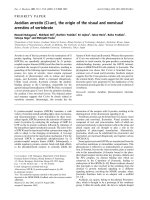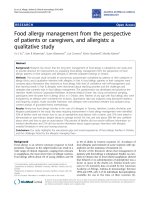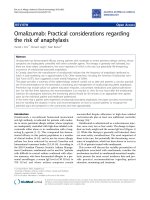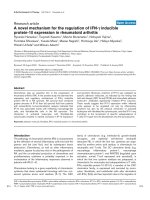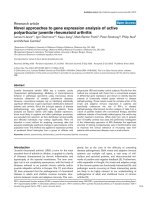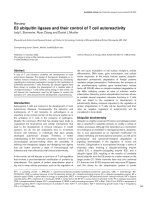Báo cáo y học: "Infliximab concentration monitoring improves the control of disease activity in rheumatoid arthritis" doc
Bạn đang xem bản rút gọn của tài liệu. Xem và tải ngay bản đầy đủ của tài liệu tại đây (303.35 KB, 6 trang )
Open Access
Available online />Page 1 of 6
(page number not for citation purposes)
Vol 11 No 6
Research article
Infliximab concentration monitoring improves the control of
disease activity in rheumatoid arthritis
Denis Mulleman
1,2
*, Jean-Camille Méric
1,2
*, Gilles Paintaud
1,3
, Emilie Ducourau
1,2
,
Charlotte Magdelaine-Beuzelin
1,4
, Jean-Pierre Valat
1,2
, Philippe Goupille
1,2,5
for the Centre National
de la Recherche Scientifique UMR 6239 GICC
1
Université François-Rabelais de Tours, 3 rue des Tanneurs, 37041 Tours Cedex 1, France
2
Centre Hospitalier Régional et Universitaire de Tours, Service de Rhumatologie, avenue de la République, 37044 Tours Cedex 9, France
3
Centre Hospitalier Régional et Universitaire de Tours, Laboratoire de Pharmacologie-Toxicologie, 2 boulevard Tonnellé, 37044 Tours Cedex 9,
France
4
Centre Hospitalier Régional et Universitaire de Tours, Laboratoire d'Immunologie, 2 boulevard Tonnellé, 37044 Tours Cedex 9, France
5
Institut National de la Santé et de la Recherche Médicale Centres Investigations Clinique 202, 2 boulevard Tonnellé, 37044 Tours Cedex 9, France
* Contributed equally
Corresponding author: Denis Mulleman,
Received: 27 Aug 2009 Revisions requested: 5 Nov 2009 Revisions received: 17 Nov 2009 Accepted: 25 Nov 2009 Published: 25 Nov 2009
Arthritis Research & Therapy 2009, 11:R178 (doi:10.1186/ar2867)
This article is online at: />© 2009 Mulleman et al.; licensee BioMed Central Ltd.
This is an open access article distributed under the terms of the Creative Commons Attribution License ( />),
which permits unrestricted use, distribution, and reproduction in any medium, provided the original work is properly cited.
Abstract
Introduction Adjustment of infliximab dosage for individuals
may be useful in improving therapeutic response in rheumatoid
arthritis (RA). Herein, we aimed to determine whether
measurement of infliximab serum concentration modifies the
therapeutic decision and improves the control of disease
activity.
Methods RA patients routinely treated with infliximab were
included in an observational open-label study. On visit 1 (V1),
according to the disease activity, a preliminary therapeutic
decision was selected among four therapeutic options and a
blood sample was collected to measure trough serum infliximab
concentration. The final therapeutic decision, based on both
disease activity and serum infliximab concentration assessed at
V1, was applied at the following infusion (V2). Clinical and
biological evaluations were performed at V3 and V4 and
compared with those at V1.
Results We included 24 patients. The final therapeutic decision
differed from the preliminary decision for 12 patients (50%). For
patients with increased infliximab dosage at V2, mean disease
activity score for 28 joints (DAS28) decreased by about 20% at
V3 or V4 as compared with V1 (P < 0.05). Decreased DAS28
was correlated with increased serum infliximab concentration (P
< 0.02).
Conclusions The measurement of infliximab trough
concentration modifies the therapeutic decision for RA patients
and helps improve control of disease activity. Therapeutic drug
monitoring of infliximab in RA may be useful for individual
dosage adjustment.
Introduction
Infliximab is a chimeric monoclonal antibody against tumor
necrosis factor-alpha (TNF-α) used in the treatment of rheuma-
toid arthritis (RA); its efficacy was demonstrated in a rand-
omized controlled trial [1]. The variable inter-individual
response is explained at least in part by individual pharmacok-
inetics [2]. Clinical response in RA is indeed influenced by inf-
liximab serum concentration [2-6], and we have recently
shown that this concentration predicts long-term disease con-
trol in daily practice [7]. Adjustment of infliximab dosage for
individuals may be useful in improving therapeutic response
[8,9]. Hence, patients with persistent active disease and low
infliximab concentrations could benefit from an increase in inf-
liximab dosage, whereas those with poor disease control and
high infliximab concentrations should switch to another biop-
harmaceutical. In contrast, patients with optimal disease con-
trol and high infliximab concentrations might benefit from a
ATI: antibody toward infliximab; DAS28: disease activity score for 28 joints; ELISA: enzyme-linked immunosorbent assay; RA: rheumatoid arthritis;
TNF-α: tumor necrosis factor-alpha; V1, V2, and so on: visit 1, visit 2, and so on.
Arthritis Research & Therapy Vol 11 No 6 Mulleman et al.
Page 2 of 6
(page number not for citation purposes)
controlled reduction in infliximab dose or an increase of dosing
intervals to decrease the risk of dose-related side effects.
We aimed to determine whether the measurement of serum
infliximab concentration modifies the therapeutic strategy and
improves the control of disease activity in RA. The secondary
objective was to study whether this improvement in control of
disease activity is related to changes in infliximab concentra-
tion.
Materials and methods
Patients
All RA patients visiting our rheumatology department from May
to August 2007 to receive their routine infliximab infusion,
according to recommendations from the French Society for
Rheumatology for patients receiving anti-TNF biopharmaceuti-
cals [10], were followed up during four visits (V1 to V4).
According to the rules applied in our setting, patients were
asked to complete a weekly questionnaire recording pain, joint
stiffness, and disease activity on visual analog scales to esti-
mate overall disease activity since the last infusion. In this
observational study, eligible patients had received at least four
infusions of infliximab, had an infliximab dose (in milligrams per
kilograms) and dosing interval (± 4 days) similar to those of the
previous infusion, had no change in use of disease-modifying
anti-rheumatic drugs since the previous infusion, and had no
pregnancy or surgery scheduled within the following three
infusions. The study design is summarized in Figure 1. The
patients gave their informed consent to participate in the
study, and the study protocol was in compliance with the Dec-
laration of Helsinki. This study was approved by our local insti-
tutional review board.
Serum concentrations of infliximab and antibody toward
infliximab
A blood sample was drawn just before each infusion from V1
to V4. Serum infliximab concentrations were measured by
enzyme-linked immunosorbent assay (ELISA) as previously
described [11]. The limit of detection of this technique is
0.014 μg/mL. The lower limit of quantitation and upper limit of
quantitation are 0.04 and 4.5 μg/mL, respectively. Serum con-
centrations of antibody toward infliximab (ATI) were measured
by double-antigen ELISA with capture by infliximab-coated
microplates and detection by peroxydase-coupled infliximab.
The ELISA was standardized by use of a mouse monoclonal
antibody to all subclasses of human IgG. The limit of detection
was 0.20 μg/mL. The technique was tested on 195 serum
samples from healthy blood donors (37%), patients with
autoimmune diseases (59.5%), and patients with hypergam-
maglobulinemia (3.5%) and did not lead to false-positive
results, even in the presence of rheumatoid factor. Because of
the interference with circulating infliximab, results were con-
clusive if the infliximab concentration in the sample was less
than 1.7 μg/mL.
Preliminary therapeutic decision (before knowing
infliximab concentration)
The preliminary therapeutic decision at V1 was based on clin-
ical and conventional laboratory marker testing. Control of dis-
ease activity was categorized as 'optimal', 'acceptable', or
'inadequate' by a combination of disease activity score for 28
joints (DAS28) and physician global assessment. Taking into
account the control of disease activity, the physician selected
a preliminary therapeutic decision from among four options:
(a) decrease infliximab dosage, (b) maintain the same inflixi-
mab dosage and possibly add another therapeutic intervention
(that is, intra-articular corticosteroid injection, physical treat-
ment, or analgesic pharmaceuticals), (c) increase infliximab
dosage, or (d) discontinue infliximab and switch to another
treatment. An increase in infliximab dosage was not possible if
the V1 dosage was considered maximal (that is, a dose of at
least 7.5 mg/kg or an interval of not more than 4 weeks).
Figure 1
Study designStudy design. Each visit corresponds to infliximab infusion and included clinical assessment, a blood sample for measurement of infliximab, and test-
ing for antibody against infliximab. The final therapeutic decision took into account infliximab concentration measured at visit 1. RA, rheumatoid arthri-
tis.
Available online />Page 3 of 6
(page number not for citation purposes)
Final therapeutic decision
The final therapeutic decision applied at V2 (Figure 1) took
into account both the assessment of disease activity and the
trough serum infliximab concentration measured at V1 (Table
1). According to available published data [2,3,12,13], a target
infliximab serum concentration of 5 μg/mL was selected.
Trough infliximab concentration was classified as low (<2.0
μg/mL), medium (≥2.0 and <8 μg/mL), or high (≥8 μg/mL).
Statistical analysis
Clinical and biological markers of disease activity, DAS28, and
trough serum infliximab concentration at V1 were compared
with those at V3 and V4. Statistical differences were analyzed
by the Wilcoxon non-parametric test for continuous variables.
The relation between change in infliximab serum concentration
and change in DAS28 from V1 to V4 was analyzed by the
Spearman non-parametric correlation test. Statistical analysis
involved Statview version 5 (SAS Institute Inc., Cary, NC,
USA). A two-tailed P value of less than 0.05 was considered
statistically significant. Results are presented as median
[range] unless otherwise stated.
Results
Characteristics of patients
A total of 24 patients (8 men) were included. The median age
was 61 years [34 to 78], and the disease duration was 10
years [5 to 58]. The median duration of infliximab treatment
was 56 months [3 to 76], and the number of previous inflixi-
mab infusions was 31 [4 to 39]. Before receiving infliximab, 2
patients (9%) had received one of the two other anti-TNF-α
biopharmaceuticals available at that time. Sixteen patients
were receiving prednisone (dose/day = 5 mg [0.5 to 10.0]),
and 20 patients were receiving methotrexate (dose = 10 mg/
week [5 to 17.5]). The median interval between infliximab infu-
sions was 8 weeks [6 to 9], and the dose of infliximab infusion
was 3.75 mg/kg [2.80 to 7.30]. The median infliximab concen-
tration was 3.00 μg/mL [0.01 to 7.80]. No patient had a high
trough infliximab concentration, 17 patients (71%) had
medium trough concentrations, and 7 (29%) had low trough
concentrations. The median erythrocyte sedimentation rate
was 14 mm/hour [5 to 49], the level of C-reactive protein was
5.0 mg/L [0.6 to 22.0], and DAS28 was 2.65 [1.48 to 6.16].
At V1, 12 patients (50%) showed optimal control of disease
activity, 5 (21%) acceptable control, and 7 (29%) inadequate
control. Only one patient was positive for ATI at V1 (2.18 μg/
mL) with a concomitant infliximab concentration that was
undetectable (0.01 μg/mL). This patient had been receiving
infliximab for 9 months. Her infliximab dosage was increased
during the study, but she eventually discontinued the treat-
ment after V4.
Difference between preliminary and final therapeutic
decision
The final therapeutic decision, taking into account serum inflix-
imab concentration, differed from the preliminary therapeutic
decision for 12 patients (50%) (Additional data file 1). For 7
patients, the infliximab dosage was increased for the final ther-
apeutic decision as compared with 3 patients for whom the
dosage was increased at the preliminary therapeutic decision.
Of the 7 patients, 6 were considered to have an inadequate
control of disease activity (2 with medium and 4 with low inflix-
imab concentration) and 1 was considered to have acceptable
control (with medium infliximab concentration).
Evolution of clinical and biological markers of disease
activity
Changes in DAS28 over time are presented in Figure 2.
DAS28 significantly improved from V1 to V3 (P < 0.05) for
patients with an increase in infliximab dosage. The mean
improvement in DAS28 for patients of this group was about
20%. The improvement as compared with V1 was maintained
at V4 (P < 0.05).
Relation between change in serum infliximab
concentration and change in disease activity
As shown in Figure 3, changes in DAS28 and infliximab con-
centration between V1 and V4 were inversely related (P <
0.02).
Table 1
Final therapeutic decision at visit 2 based on disease activity control and serum trough infliximab concentration
Control of disease activity
Optimal Acceptable Inadequate
High: C (μg/mL) ≥8.0 Decrease infliximab
dosage
Maintain same infliximab
dosage
Switch to another
biopharmaceutical
Infliximab trough
concentration
Medium: 2.0 ≤ C (μg/mL)
<8.0
Maintain same infliximab
dosage
Consider increasing infliximab dosage
a
Increase infliximab dosage
Low: C (μg/mL) <2.0 Maintain same infliximab
dosage
Infliximab dosage could not be increased if the current dosage was considered maximal (that is, at least 7.5 mg/kg or interval of not more than 4
weeks).
a
If the physician kept the same infliximab dosage, another therapeutic intervention could be added (that is, intra-articular corticosteroid
injection, physical treatment, or analgesic pharmaceuticals). C, concentration.
Arthritis Research & Therapy Vol 11 No 6 Mulleman et al.
Page 4 of 6
(page number not for citation purposes)
Discussion
To our knowledge, this is the first study to highlight the useful-
ness of pharmacokinetic monitoring of infliximab concentration
to control disease activity in RA. Indeed, the measurement of
trough infliximab concentration modified the therapeutic deci-
sion for half of our patients and led to improved control of dis-
ease activity for patients for whom infliximab dosage was
increased. Our results confirm those of a clinical observational
study that did not monitor infliximab concentrations [8]. The
strength of our approach lies in a strategy that took into
account both disease activity and serum infliximab concentra-
tion.
The second important finding is the relation between increase
in serum infliximab concentration and clinical improvement, as
measured by the DAS28. Because concomitant medications
remained unchanged during the study for patients whose inf-
liximab dosage had been increased, the improvement in
DAS28 should have resulted from the increase in infliximab
concentration. Our results also confirm the inter-individual var-
iability of infliximab pharmacokinetics. Despite a median inflixi-
mab dose (3.75 mg/kg [2.80 to 7.30]) above that
recommended in patients with RA, 7 patients (29%) had low
trough concentrations.
Clinicians can face two situations with RA patients receiving
infliximab. The first corresponds to patients with optimal dis-
ease control, for whom the physician could consider reducing
infliximab dosage. However, a decrease in infliximab dosage
without infliximab concentration monitoring may lead to under-
exposure, a situation that can predict insufficient control of dis-
ease activity and increased risk of positivity for ATI [4,14]. For
the preliminary therapeutic decision, infliximab dosage reduc-
tion was planned for 6 patients; however, because these
patients were all considered satisfactorily exposed or underex-
posed, they continued the same regimen for the final therapeu-
tic decision. The second situation corresponds to patients
with disease control the physician considers acceptable or
inadequate. In this situation, the physician could consider
increasing the infliximab dosage to improve the control of dis-
ease activity. However, concerns arise in the prolonged use of
TNF-α antagonists, especially at high doses [15]. Therefore,
the measurement of serum infliximab concentration in this sit-
uation could be useful to avoid an unnecessary increase in
dosage in patients with concurrent high infliximab concentra-
tion and hence a risk of dose-dependent side effects. Monitor-
ing of infliximab concentrations in this situation would lead the
clinician to increase the dosage only if the patient does not
have a high infliximab concentration. Therapeutic drug moni-
toring of infliximab could result in a lowering of dosage in
patients having higher exposure than needed, in an increasing
of dosage in others, or in a discontinuation of infliximab in non-
responders with high exposure. As a whole, such a strategy
should improve the cost-effectiveness of infliximab in RA.
Our method to determine infliximab serum concentration
detects the active form of infliximab (that is, the species that
can bind to TNF-α), not infliximab molecules that are already
bound to TNF-α or ATI. The choice of measuring the active
form allows investigators to analyze the concentration-effect
relationship.
Immunogenicity induced by anti-TNF-α biopharmaceuticals
has been associated with low concentrations and poor clinical
outcomes [16]. Our technique for ATI detection was limited by
the presence of circulating infliximab. The problem is well
known and is encountered whatever the method used [17].
Also, ATI may have underestimated the infliximab determina-
tion by neutralizing both infliximab paratopes. However, such
undetectable infliximab molecules are inactive and cannot be
taken into account for pharmacokinetic-pharmacodynamic
analysis. Positivity for ATI influences the pharmacokinetics of
Figure 2
Relative change in mean disease activity score for 28 joints (DAS28) over time according to final therapeutic decision (Table 1)Relative change in mean disease activity score for 28 joints (DAS28)
over time according to final therapeutic decision (Table 1). *P < 0.05.
Figure 3
Relation between change in serum infliximab concentration and change in disease activity score for 28 joints (DAS28) from visit 1 to visit 4Relation between change in serum infliximab concentration and change
in disease activity score for 28 joints (DAS28) from visit 1 to visit 4.
Because of missing data, four patients are not represented.
Available online />Page 5 of 6
(page number not for citation purposes)
infliximab in ankylosing spondylitis [18] and inflammatory
bowel disease [19], but the determining factor in the concen-
tration-effect relation of infliximab is infliximab itself.
Only one patient was positive for ATI, and this can be
explained by the duration of infliximab treatment, 56 months [3
to 76]. Indeed, patients positive for ATI probably had already
switched to another treatment because of clinical signs of
immunization or secondary failure of treatment. ATI false-neg-
ative results may have occurred for sera with detectable inflix-
imab concentrations.
Our study has several limitations. Because it is an open-label
observational study, patients may have been influenced by the
therapeutic decision, especially those who were notified of an
increase in infliximab dosage. Therefore, our results need to be
confirmed by a randomized controlled study comparing thera-
peutic drug monitoring of infliximab with usual care. Also, our
approach, based on a single clinical assessment, can be
applied only for patients considered to have stable disease
activity and not those with acute flare, whose condition
requires a rapid therapeutic intervention. Because patients
with acute flare were not considered in our study, we cannot
extend our strategy to such patients. Because RA activity var-
ies with time, we used a weekly diary to estimate global dis-
ease activity between two consecutive infusions to limit this
factor. Another limitation of our study is that our population of
RA patients had been treated for a long time with infliximab.
Whether a dosage adjustment during the early initiation of
treatment could be of benefit in terms of response is a chal-
lenging question. Since the concentration-effect relationship
of infliximab is poorly known, therapeutic drug monitoring will
be more difficult to test at treatment initiation. For that reason,
our results apply only to RA patients with a relatively long
period of treatment, not to patients at their initiation.
Conclusions
The measurement of serum trough infliximab concentration
modifies the therapeutic decision for RA patients and leads to
improved control of disease activity. Thus, therapeutic drug
monitoring of infliximab may improve the control of disease
activity in RA.
Competing interests
DM and J-PV took part in clinical trials as co-investigators for
Abbott (Abbott Park, IL, USA), Schering-Plough Corporation
(Kenilworth, NJ, USA), Wyeth (Madison, NJ, USA), Roche
(Basel, Switzerland), and Bristol-Myers Squibb Company
(Princeton, NJ, USA). PG participated in clinical trials as a co-
investigator and as a study contributor for Abbott, Schering-
Plough Corporation, Wyeth, Roche, and Bristol-Myers Squibb
Company and took part in conferences and provided expert
reports and advisory services for L.F.B. (Courtabœuf, France),
Roche, Schering-Plough Corporation, and Wyeth. GP took
part in conferences and provided expert reports and advisory
services for L.F.B., Roche, Schering-Plough Corporation, and
Wyeth. CM-B had occasional involvement with expert reports
for Abbott. All other authors declare that they have no compet-
ing interests.
Authors' contributions
DM and J-CM supervised the study design, performed the sta-
tistical analysis, and drafted the manuscript. GP participated in
the study design, carried out the immuno assays (infliximab
serum concentration), and helped to draft the manuscript. PG
participated in the study design and helped to draft the manu-
script. CM-B carried out the immuno assays (antibodies
toward infliximab serum concentration). ED and J-PV helped to
draft the manuscript. All authors read and approved the final
manuscript.
Additional files
Acknowledgements
The authors thank Marie-Françoise Coudray, Françoise Gouais, Martine
Creton, Fabienne Chapacou, and Dominique Guillou for blood sam-
pling; Anne-Claire Duveau for technical assistance in infliximab concen-
tration measurements; Delphine Chu Miow Lin and Francine Lauféron
for recruiting and assessing patients; Julie Allais for invaluable help in
collecting data; and Laura Heraty for her kind assistance with the man-
uscript.
References
1. Maini R, St Clair EW, Breedveld F, Furst D, Kalden J, Weisman M,
Smolen J, Emery P, Harriman G, Feldmann M, Lipsky P: Infliximab
(chimeric anti-tumour necrosis factor alpha monoclonal anti-
body) versus placebo in rheumatoid arthritis patients receiv-
ing concomitant methotrexate: a randomised phase III trial.
ATTRACT Study Group. Lancet 1999, 354:1932-1939.
2. St Clair EW, Wagner CL, Fasanmade AA, Wang B, Schaible T,
Kavanaugh A, Keystone EC: The relationship of serum inflixi-
mab concentrations to clinical improvement in rheumatoid
arthritis: results from ATTRACT, a multicenter, randomized,
double-blind, placebo-controlled trial. Arthritis Rheum 2002,
46:1451-1459.
3. Wolbink GJ, Voskuyl AE, Lems WF, de Groot E, Nurmohamed MT,
Tak PP, Dijkmans BA, Aarden L: Relationship between serum
The following Additional files are available online:
Additional file 1
Differences between preliminary and final therapeutic
decision. At visit 1 (V1), 24 rheumatoid arthritis (RA)
patients received a preliminary therapeutic decision that
corresponded to the following options: decrease
infliximab dosage; same infliximab dosage plus another
intervention; increase infliximab dosage; discontinue
infliximab; and switch to another treatment. The final
decision (same options) applied at V2 took into account
disease activity control and trough infliximab
concentration measured at V1 (Table 1).
See />supplementary/ar2867-S1.JPEG
Arthritis Research & Therapy Vol 11 No 6 Mulleman et al.
Page 6 of 6
(page number not for citation purposes)
trough infliximab levels, pretreatment C reactive protein levels,
and clinical response to infliximab treatment in patients with
rheumatoid arthritis. Ann Rheum Dis 2005, 64:704-707.
4. Bendtzen K, Geborek P, Svenson M, Larsson L, Kapetanovic MC,
Saxne T: Individualized monitoring of drug bioavailability and
immunogenicity in rheumatoid arthritis patients treated with
the tumor necrosis factor alpha inhibitor infliximab. Arthritis
Rheum 2006, 54:3782-3789.
5. Rahman MU, Strusberg I, Geusens P, Berman A, Yocum D, Baker
D, Wagner C, Han J, Westhovens R: Double-blinded infliximab
dose escalation in patients with rheumatoid arthritis. Ann
Rheum Dis 2007, 66:1233-1238.
6. Mori S: A relationship between pharmacokinetics (PK) and the
efficacy of infliximab for patients with rheumatoid arthritis:
characterization of infliximab-resistant cases and PK-based
modified therapy. Mod Rheumatol 2007, 17:83-91.
7. Chu Miow Lin D, Ducourau E, Mulleman D, Emond P, Ternant D,
Paintaud G, Valat J-P, Goupille P: Infliximab concentration is
predictive of control of disease activity and maintenance of
treatment in rheumatoid arthritis [abstract][French]. Ann
Rheum Dis 2008, 67(Suppl 2):P177.
8. Durez P, Bosch F Van den, Corluy L, Veys EM, De Clerck L, Peretz
A, Malaise M, Devogelaer JP, Vastesaeger N, Geldhof A, West-
hovens R: A dose adjustment in patients with rheumatoid
arthritis not optimally responding to a standard dose of inflix-
imab of 3 mg/kg every 8 weeks can be effective: a Belgian
prospective study. Rheumatology (Oxford) 2005, 44:465-468.
9. Collantes-Estevez E, Muñoz-Villanueva MC, Zarco P, Torre-Alonso
JC, Gratacós J, González C, Sanmartí R, Cañete JD, Spanish
Spondyloarthropathies Study Group: Effectiveness of reducing
infliximab dose interval in non-responder patients with refrac-
tory spondyloarthropathies. An open extension of a multicen-
tre study. Rheumatology (Oxford) 2005, 44:1555-1558.
10. Fautrel B, Pham T, Mouterde G, Le Loet X, Goupille P, Guillemin F,
Ravaud P, Cantagrel A, Dougados M, Puechal X, Sibilia J, Soubrier
M, Mariette X, Combe B, Club Rhumatismes et Inflammation;
Société Française de Rhumatologie: Recommendations of the
French Society for Rheumatology regarding TNFalpha antag-
onist therapy in patients with rheumatoid arthritis. Joint Bone
Spine 2007, 74:627-637.
11. Ternant D, Mulleman D, Degenne D, Willot S, Guillaumin JM,
Watier H, Goupille P, Paintaud G: An enzyme-linked immuno-
sorbent assay for therapeutic drug monitoring of infliximab.
Ther Drug Monit 2006, 28:169-174.
12. Baert F, Noman M, Vermeire S, Van Assche G, D' Haens G, Car-
bonez A, Rutgeerts P: Influence of immunogenicity on the long-
term efficacy of infliximab in Crohn's disease. N Engl J Med
2003, 348:601-608.
13. Cornillie F, Shealy D, D'Haens G, Geboes K, Van Assche G, Ceu-
ppens J, Wagner C, Schaible T, Plevy SE, Targan SR, Rutgeerts
P: Infliximab induces potent anti-inflammatory and local
immunomodulatory activity but no systemic immune suppres-
sion in patients with Crohn's disease. Aliment Pharmacol Ther
2001, 15:463-473.
14. Wolbink GJ, Vis M, Lems W, Voskuyl AE, de Groot E, Nurmo-
hamed MT, Stapel S, Tak PP, Aarden L, Dijkmans B: Development
of antiinfliximab antibodies and relationship to clinical
response in patients with rheumatoid arthritis. Arthritis Rheum
2006, 54:711-715.
15. Bongartz T, Sutton AJ, Sweeting MJ, Buchan I, Matteson EL, Mon-
tori V: Anti-TNF antibody therapy in rheumatoid arthritis and
the risk of serious infections and malignancies: systematic
review and meta-analysis of rare harmful effects in rand-
omized controlled trials. JAMA 2006, 295:2275-2285.
16. Emi Aikawa N, de Carvalho JF, Artur Almeida Silva C, Bonfa E:
Immunogenicity of anti-TNF-alpha agents in autoimmune dis-
eases. Clin Rev Allergy Immunol 2009 in press.
17. Radstake TR, Svenson M, Eijsbouts AM, Hoogen FH van den,
Enevold C, van Riel PL, Bendtzen K: Formation of antibodies
against infliximab and adalimumab strongly correlates with
functional drug levels and clinical responses in rheumatoid
arthritis. Ann Rheum Dis 2009, 68:1739-1745.
18. Xu Z, Seitz K, Fasanmade A, Ford J, Williamson P, Xu W, Davis
HM, Zhou H: Population pharmacokinetics of infliximab in
patients with ankylosing spondylitis. J Clin Pharmacol 2008,
48:681-695.
19. Ternant D, Aubourg A, Magdelaine-Beuzelin C, Degenne D, Watier
H, Picon L, Paintaud G: Infliximab pharmacokinetics in inflam-
matory bowel disease patients. Ther Drug Monit 2008,
30:523-529.
